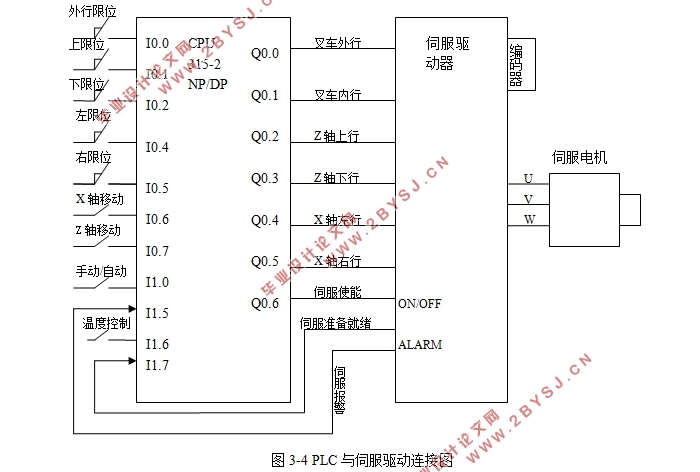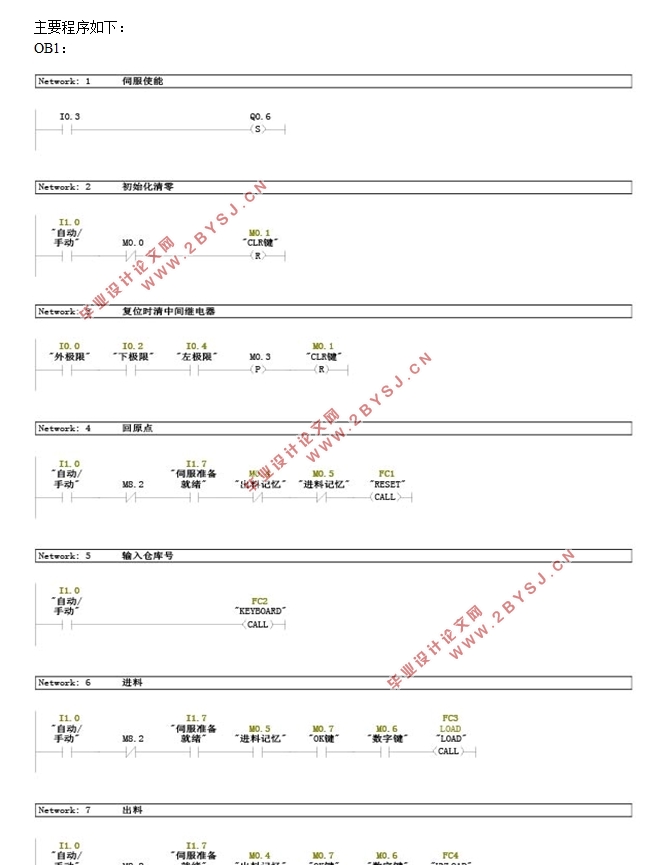PLC与伺服驱动系统设计(附程序)
无需注册登录,支付后按照提示操作即可获取该资料.
PLC与伺服驱动系统设计(附程序)(任务书,开题报告,论文12000字,程序)
摘 要
本文首先对PLC与伺服驱动系统设计的意义、背景、研究状况、进行介绍,并分别对可编程逻辑控制器、伺服驱动器和伺服电机的定义、组成、工作原理分别进行了介绍,并介绍了自动化立体仓库的基本知识,包括它的组成、特点。自动化立体仓库采用PLC S7-300,然后由于系统需要,设计PLC与伺服驱动系统的硬件结构,包括PLC各个模块的选型,伺服驱动系统的选择,PLC与伺服驱动系统的连线。最后设计基于PLC S7-300与伺服驱动系统的自动化立体仓库的功能图,输入输出分配表,立体仓库的流程图。本文中的程序在STEP 7 中进行程序的编写,采用模块化设计的方式实现堆垛机的键盘控制、进料、出料、复位、等功能。
关键词:PLC S7-300 伺服驱动 立体仓库
Design of PLC and Servo Drive System
Abstract
In this paper, the meaning, background and research status of PLC and servo drive system design are introduced. The definition, composition and working principle of programmable logic controller, servo drive and servo motor are introduced respectively, and the automation The basic knowledge of the three-dimensional warehouse, including its composition, characteristics, classification. Automated three-dimensional warehouse using PLC S7-300, and then because the system needs, design PLC and servo drive system hardware structure, including PLC module selection, servo drive system selection, PLC and servo drive system connection. Finally, based on the PLC S7-300 and servo drive system of automated warehouse function diagram, input and output distribution table, three-dimensional warehouse flow chart. The program in this article in STEP 7 program preparation and simulation, using modular design to achieve the way the stacker keyboard control, feed, discharge, reset, and other functions.
Key Words: PLC S7-300; Servo drive; automated warehouse



目 录
摘 要 I
Abstract II
第一章 绪论 1
1.1选题背景及意义 1
1.2国内外研究现状 1
1.3课题研究内容 3
第二章 PLC与伺服系统的简介 4
2.1 PLC控制系统 4
2.1.1 PLC的基本概念 4
2.1.2 PLC的应用领域 7
2.2伺服驱动系统 8
2.2.1概述 8
2.2.2特性 8
2.2.3控制伺服驱动的设计概述 9
2.3 自动化立体仓库 10
2.3.1 组成 10
2.3.2 优点 11
2.4 本章小结 12
第三章硬件设计 13
3.1 PLC的选择 13
3.2伺服驱动系统的选择 14
3.3系统评估 14
3.4原理图 16
3.5接线图 16
3.6本章小结 18
第四章 软件设计 19
4.1 STEP软件 19
4.1.1 Step 7介绍 19
4.1.2 Step 7编程语言 19
4.1.3 Step 7的程序结构 19
4.2立体仓库功能图 20
4.2 立体仓库输入输出点分配 21
4.3 立体仓库流程图 22
4.4 程序设计 23
4.5.系统仿真 29
4.6 本章小结 31
第五章 总结与展望 32
5.1 总结 32
5.2展望 32
参考文献 33
附录 34
